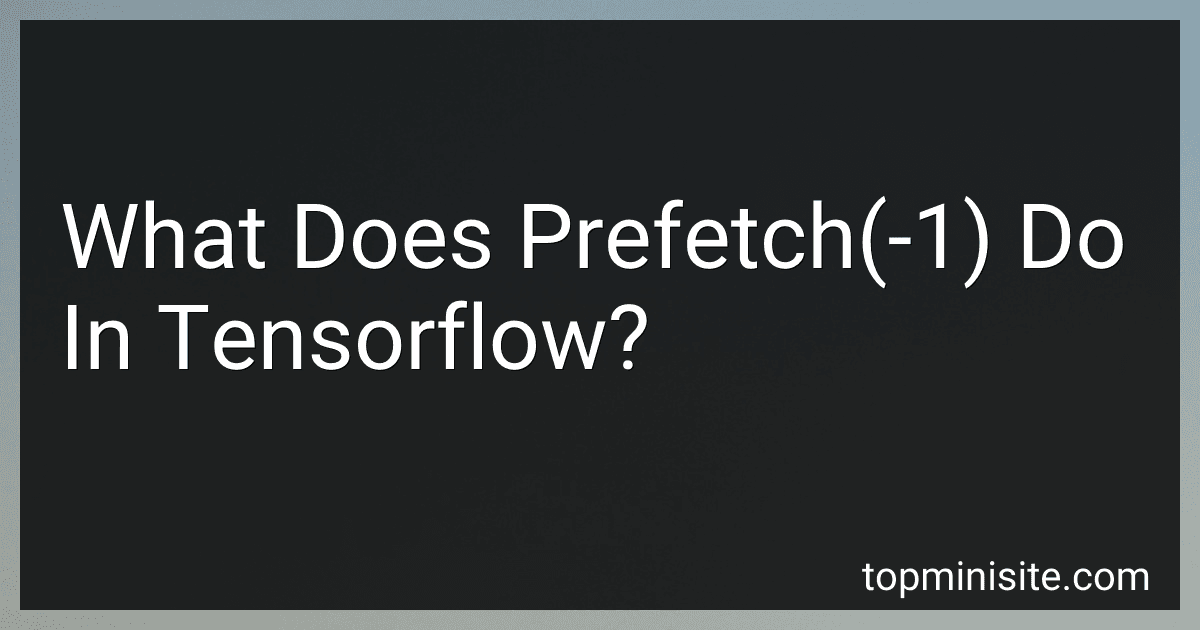Best TensorFlow Resources to Buy in December 2025
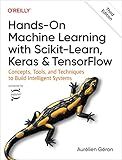
Hands-On Machine Learning with Scikit-Learn, Keras, and TensorFlow


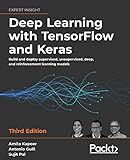
Deep Learning with TensorFlow and Keras: Build and deploy supervised, unsupervised, deep, and reinforcement learning models, 3rd Edition


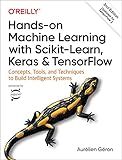
Hands-On Machine Learning with Scikit-Learn, Keras, and TensorFlow: Concepts, Tools, and Techniques to Build Intelligent Systems


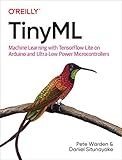
TinyML: Machine Learning with TensorFlow Lite on Arduino and Ultra-Low-Power Microcontrollers


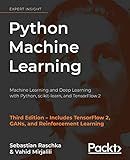
Python Machine Learning: Machine Learning and Deep Learning with Python, scikit-learn, and TensorFlow 2, 3rd Edition



Learning Deep Learning: Theory and Practice of Neural Networks, Computer Vision, Natural Language Processing, and Transformers Using TensorFlow


In TensorFlow, the prefetch(-1) function is used to prefetch elements from a dataset. When -1 is passed as the argument, TensorFlow will automatically determine the optimal buffer size based on available system resources to prefetch elements from the dataset. This can help in overlapping data preprocessing and model execution, resulting in improved overall performance and efficiency during the training process.
How to implement a prefetch(-1) strategy for dynamic data sets in tensorflow?
To implement a prefetch(-1) strategy for dynamic data sets in TensorFlow, you can use the tf.data API which allows for efficient and parallel data processing.
Here is an example code snippet to implement prefetch(-1) strategy for dynamic data sets in TensorFlow:
import tensorflow as tf
Create a dataset from a placeholder
data_placeholder = tf.placeholder(tf.float32, shape=[None]) dataset = tf.data.Dataset.from_tensor_slices(data_placeholder) dataset = dataset.prefetch(-1)
Create an iterator for the dataset
iterator = dataset.make_initializable_iterator() next_element = iterator.get_next()
Initialize the dataset with a data set
with tf.Session() as sess: data = [1, 2, 3, 4, 5]
# Initialize the iterator with data
sess.run(iterator.initializer, feed\_dict={data\_placeholder: data})
# Get the next element from the iterator
while True:
try:
element = sess.run(next\_element)
print(element)
except tf.errors.OutOfRangeError:
break
In this example, we first create a dataset from a placeholder and set the prefetch buffer size to -1. We then create an iterator for the dataset and initialize it with a data set. Finally, we get the next element from the iterator until there are no more elements left in the dataset.
This prefetch(-1) strategy ensures that the next batch of data is always ready to be processed, leading to improved performance and reduced processing time.
What is the theoretical advantage of prefetch(-1) over other data loading techniques in tensorflow?
The theoretical advantage of prefetch(-1) in TensorFlow is that it allows the data loading and processing to be significantly decoupled from the training process. By prefetching data with a buffer size of -1, TensorFlow can automatically adjust the buffer size based on the available system resources, maximizing the efficiency of the data loading process. This helps to ensure that the training process is not bottlenecked by slow data loading, leading to faster overall training times and potentially improved model performance. Additionally, prefetching data with a buffer size of -1 can help to minimize the impact of data loading latency on the overall training process, allowing the GPU to be utilized more efficiently and reducing idle time.
What is the recommended data pipeline structure when using prefetch(-1) in tensorflow?
When using prefetch(-1) in TensorFlow, the recommended data pipeline structure is to use the tf.data API to efficiently load and preprocess data in a parallel and non-blocking manner. Here is an example of a recommended data pipeline structure:
- Load the dataset using a tf.data.Dataset object, such as from_tensor_slices() or from_generator().
- Apply any necessary preprocessing steps using the map() function, such as data augmentation, normalization, or resizing.
- Use the cache() function to cache the dataset in memory for faster access during training.
- Shuffle the dataset using the shuffle() function to prevent the model from learning the order of the data.
- Use the batch() function to create batches of data for training.
- Use the prefetch(-1) function to prefetch batches of data in a background thread, ensuring that the data is always ready for the model to consume.
By following the above data pipeline structure, you can ensure that the data is efficiently loaded, preprocessed, and fed to the model for training, while minimizing any potential bottlenecks caused by slow data loading or preprocessing.
How to handle data augmentation in conjunction with prefetch(-1) in tensorflow?
When using data augmentation in conjunction with prefetch(-1) in TensorFlow, it is important to make sure that the data augmentation is performed before the prefetch operation. This is because prefetch(-1) loads the next batch of data asynchronously while the current batch is being processed, and if data augmentation is performed after prefetch, it may cause the pipeline to run out of data.
One way to handle this is to create a data augmentation pipeline using functions from the tf.image module in TensorFlow, and then apply this pipeline to the dataset before prefetching. This ensures that the data augmentation is applied to the data before it is prefetched.
Here is an example of how to handle data augmentation in conjunction with prefetch(-1) in TensorFlow:
# Create a data augmentation pipeline def augment_data(image, label): image = tf.image.random_flip_left_right(image) image = tf.image.random_brightness(image, max_delta=0.1) return image, label
Apply data augmentation to the dataset
dataset = dataset.map(augment_data)
Prefetch the data
dataset = dataset.prefetch(-1)
In this example, the augment_data function applies random left-right flipping and random brightness adjustment to the images in the dataset. This function is then mapped to the dataset using the map function to apply the data augmentation to each batch of data before prefetching.
By ensuring that data augmentation is performed before prefetching, you can effectively handle data augmentation in conjunction with prefetch(-1) in TensorFlow.
What is the impact of prefetch(-1) on CPU and GPU utilization in tensorflow?
In TensorFlow, prefetching data into the GPU memory with a value of -1 means having an unlimited prefetch buffer size. This allows TensorFlow to automatically decide on the number of elements to prefetch at any given time, potentially filling up the memory with a large number of elements.
The impact of prefetch(-1) on CPU and GPU utilization in TensorFlow can vary depending on the specific workflow and dataset being used. Some potential impacts are:
- Increased GPU utilization: Prefetching data with an unlimited buffer size can potentially lead to higher GPU utilization as the GPU can be kept busy processing a continuous stream of data without having to wait for data to be transferred from the CPU.
- Decreased CPU utilization: Since data can be prefetched directly into GPU memory, the CPU may have lower utilization as it does not need to manage data transfers between CPU and GPU as frequently.
- Potential memory issues: Prefetching a large amount of data with an unlimited buffer size can potentially lead to memory issues, especially if the GPU memory is limited. It is important to monitor memory usage to ensure that prefetching does not lead to out-of-memory errors.
- Increased overall training performance: By effectively utilizing GPU resources and reducing CPU overhead, prefetch(-1) can lead to improved training performance and shorter training times.
Overall, prefetch(-1) can be a useful optimization technique in TensorFlow to improve data pipeline efficiency and training performance, but it is important to monitor resource usage and adjust the prefetch buffer size as needed to avoid potential issues.
How to manage resource contention issues with prefetch(-1) in tensorflow?
Resource contention issues with prefetch(-1) in TensorFlow can be managed by following these strategies:
- Increase buffer size: One way to mitigate resource contention issues is to increase the buffer size when using prefetch(-1). By increasing the buffer size, you can reduce the chances of contention for resources and improve the overall performance of your model.
- Reduce the number of parallel calls: Another approach is to reduce the number of parallel calls when using prefetch(-1). By limiting the number of parallel calls, you can reduce the amount of contention for resources and improve the overall efficiency of your model.
- Use asynchronous processing: You can also try using asynchronous processing when prefetching data in TensorFlow. By using asynchronous processing, you can minimize resource contention and improve the overall performance of your model.
- Monitor resource utilization: It is important to monitor resource utilization when using prefetch(-1) in TensorFlow. By keeping track of resource utilization, you can identify potential contention issues and take proactive measures to address them.
- Optimize data loading pipeline: Lastly, optimizing your data loading pipeline can also help in managing resource contention issues with prefetch(-1) in TensorFlow. By streamlining and optimizing your data loading pipeline, you can reduce resource contention and improve the overall efficiency of your model.
